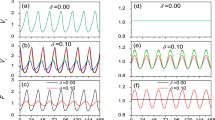Abstract
In mammals, circadian rhythms are controlled by the neurons located in the suprachiasmatic nucleus (SCN) of the hypothalamus. Each neuron in the SCN contains an autonomous molecular clock. The fundamental question is how the individual cellular oscillators, expressing a wide range of periods, interact and assemble to achieve phase synchronization. Most of the studies carried out so far emphasize the crucial role of the periodicity imposed by the light-dark cycle in neuronal synchronization. However, in natural conditions, the interaction between the SCN neurons is non-negligible and coupling between cells in the SCN is achieved partly by neurotransmitters. In this paper, we use a model of nonidentical, globally coupled cellular clocks considered as Goodwin oscillators. We mainly study the synchronization induced by coupling from an analytical way. Our results show that the role of the coupling is to enhance the synchronization to the external forcing. The conclusion of this paper can help us better understand the mechanism of circadian rhythm.








Similar content being viewed by others
References
Antle MC, Foley DK, Foley NC, Silver R (2003) Gates and oscillators: a network model of the brain clock. J Biol Rhythms 18(4):339–350
Antle MC, Foley NC, Foley DK, Silver R (2007) Gates and oscillators II: zeitgebers and the network model of the brain clock. J Biol Rhythms 22(1):14–25
Aton S, Colwell C, Harmar A, Waschek J, Herzog E (2005) Vasoactive intestinal polypeptide mediates circadian rhythmicity and synchrony in mammalian clock neurons. Nat Neurosci 8:476–483
Benuskova L, Kasabov N (2008) Modeling brain dynamics using computational neurogenetic approach. Cogn Neurodyn 2(4):319–334
Bush W, Siegelman HT (2006) Circadian synchrony in networks of protein rhythm driven neurons. Complexity 12:67–72
Gonze D, Bernard S, Waltermann C, Kramer A, Herzel H (2005) Spontaneous synchronization of coupled circadian oscillators. Biophys J 89:120–129
Goodwin B (1965) Oscillatory behavior in enzymatic control processes. Adv Enzyme Regul 3:524–438
Hamada T, LeSauter J, Venuti JM, Silver R (2001) Expression of Period genes: rhythmic and nonrhythmic compartments of the suprachiasmatic nucleus pacemaker. J Neurosci 21(19):7742–7750
Hastings M, Herzog E (2004) Clock genes, oscillators, and cellular networks in the suprachiasmatic nuclei. J Biol Rhythms 19:400–413
Honma S, Nakamura W, Shirakawa T, Honma K (2004) Diversity in the circadian periods of single neurons of the rat suprachiasmatic nucleus on nuclear structure and intrinsic period. Neurosci Lett 358:173–176
Indic P, Schwartz WJ, Herzog ED, Foley NC, Antle MC (2007) Modeling the behavior of coupled cellular circadian oscillators in the suprachiasmatic nucleus. J Biol Rhythms 22(3):211–219
Jiao XF, Wang RB (2006) Synchronization in neuronal population with the variable coupling strength in the presence of external stimulus. Appl Phys Lett 88:203901
Jordi GO, Michael BE, Steven HS (2004) Modeling a synthetic multicellular clock: repressilators coupled by quorum sensing. PNAS 101(30):10955–10960
Katriel G (2008) Synchronization of oscillators coupled through an environment. Phys D 237:2933–2944
Komin N, Murza AC, Hernandez-Garcia E, Toral R (2011) Synchronization and entrainment of coupled circadian oscillators. Biol Phys 1:167–176
Kori H, Kawamura Y, Masuda N (2012) Structure of cell networks critically determines oscillation regularity. J Theor Biol 297:61–72
Li Y, Zhang J, Liu Z (2006) Circadian oscillators and phase synchronization under a light-dark cycle. Int J Nonlinear Sci 1(3):131–138
Liu C, Reppert SM (2000) GABA synchronizes clock cells within the suprachiasmatic circadian clock. Neuron 25:123–128
Liu Y, Wang RB, Zhang ZK, Jiao XF (2010) Analysis on stability of neural network in the presence of inhibitory neurons. Cogn Neurodyn 4(1):61–68
Matsuura H, Tateno K, Aou S (2008) Dynamical properties of the two-process model for sleep-wake cycles in infantile autism. Cogn Neurodyn 2(3):221–228
Maywood ES, Reddy AB, Wong GKY, ONeill JS, OBrien JA, McMahon DG, Harmar AJ, Okamura H, Hastings MH (2006) Synchronization and maintenance of timekeeping in suprachiasmatic circadian clock cells by neuropeptidergic signaling. Curr Biol 16:599–605
Moore RY, Speh JC, Leak RK (2002) Suprachiasmatic nucleus organization. Cell Tissue Res 309:89–98
Reppert S, Weaver D (2001) Molecular analysis of mammalian circadian rhythms. Annu Rev Physiol 63:647–676
Reppert S, Weaver D (2002) Coordination of circadian timing in mammals. Nature 418:935–941
Rougemont J, Naef F (2006) Collective synchronization in populations of globally coupled phase oscillators with drifting frequencies. Phys Rev E 73:011104(5)
Shirakawa T, Honma S, Katsuno Y, Oguchi H, Honma K (2001) Multiple oscillators in the suprachiasmatic nucleus. Chronobiol Int 18:371–387
To TL, Henson MA, Herzog ED, Doyle FJ III (2007) A molecular model for intercellular synchronization in the mammalian circadian clock. Biophys J 92:3792–3803
Ullner E, Buceta J, Díez-Noguera A, García-Ojalvo J (2009) Noise-Induced coherence in multicellular circadian clocks. Biophys J 96:3573–3581
Vasalou C, Herzog ED, Henson MA (2009) Small-world network models of intercellular coupling predict enhanced synchronization in the suprachiasmatic nucleus. J Biol Rhythms 24(3):243–54
Vasalou C, Henson MA (2011) A multicellular model for differential regulation of circadian signals in the core and shell regions of the suprachiasmatic nucleus. J Theor Biol 7(288):44–56
Wang RB, Zhang ZK, Qu JY, Cao JT (2011) Phase synchronization motion and neural coding in dynamic transmission of neural information. IEEE Trans Neural Netw 22(7):1097–1106
Wang RB, Zhang ZK, Tseb CK, Qu JY, Cao JT (2011b) Neuralcoding in networks of multi-populations of neuraloscillators. Math Comput Simul doi:10.1016/j.matcom.2010.10.029
Welsh DK, Logothetis DE, Meister M, Reppert SM (1995) Individual neurons dissociated from rat suprachiasmatic nucleus express independently phased circadian firing rhythms. Neuron 14:697–706
Yamaguchi S, Isejima H, Matsuo T, Okura R, Yagita K, Kobayashi M, Okamura H (2003) Synchronization of cellular clocks in the suprachiasmatic nucleus. Science 302:1408–1412
Acknowledgments
This research is supported by the NNSF of China (Grant No: 11102106 and 11172158).
Author information
Authors and Affiliations
Corresponding author
Rights and permissions
About this article
Cite this article
Li, Y., Liu, Z., Luo, J. et al. Coupling-induced synchronization in multicellular circadian oscillators of mammals. Cogn Neurodyn 7, 59–65 (2013). https://doi.org/10.1007/s11571-012-9218-9
Received:
Revised:
Accepted:
Published:
Issue Date:
DOI: https://doi.org/10.1007/s11571-012-9218-9




